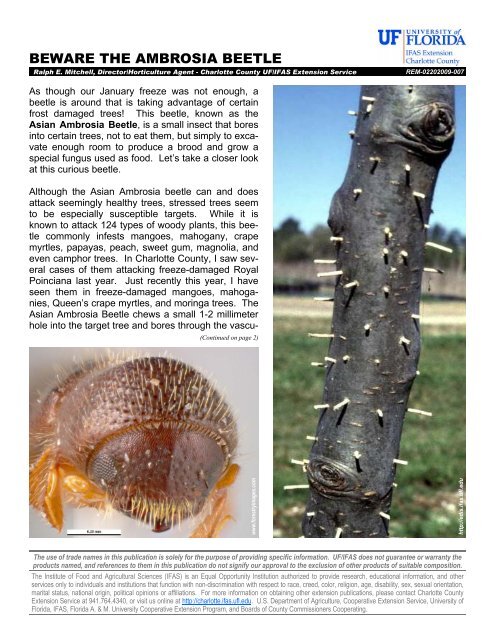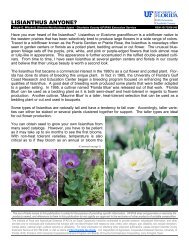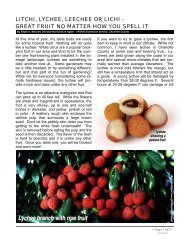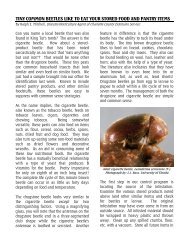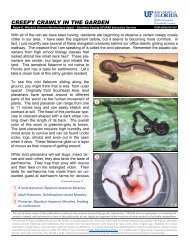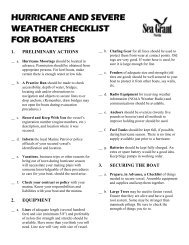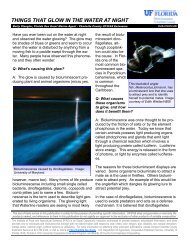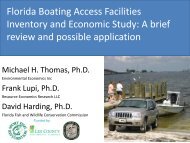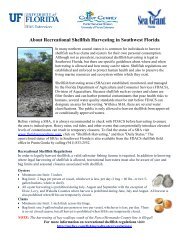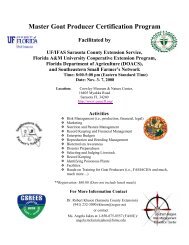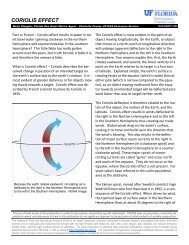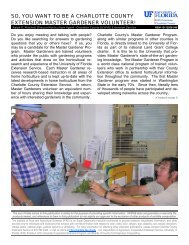Asian Ambrosia Beetle - Charlotte County Cooperative Extension
Asian Ambrosia Beetle - Charlotte County Cooperative Extension
Asian Ambrosia Beetle - Charlotte County Cooperative Extension
- No tags were found...
Create successful ePaper yourself
Turn your PDF publications into a flip-book with our unique Google optimized e-Paper software.
BEWARE THE AMBROSIA BEETLE<br />
Ralph E. Mitchell, Director/Horticulture Agent - <strong>Charlotte</strong> <strong>County</strong> UF/IFAS <strong>Extension</strong> Service<br />
REM-09052008-034<br />
REM-02202009-007<br />
As though our January freeze was not enough, a<br />
beetle is around that is taking advantage of certain<br />
frost damaged trees! This beetle, known as the<br />
<strong>Asian</strong> <strong>Ambrosia</strong> <strong>Beetle</strong>, is a small insect that bores<br />
into certain trees, not to eat them, but simply to excavate<br />
enough room to produce a brood and grow a<br />
special fungus used as food. Let’s take a closer look<br />
at this curious beetle.<br />
Although the <strong>Asian</strong> <strong>Ambrosia</strong> beetle can and does<br />
attack seemingly healthy trees, stressed trees seem<br />
to be especially susceptible targets. While it is<br />
known to attack 124 types of woody plants, this beetle<br />
commonly infests mangoes, mahogany, crape<br />
myrtles, papayas, peach, sweet gum, magnolia, and<br />
even camphor trees. In <strong>Charlotte</strong> <strong>County</strong>, I saw several<br />
cases of them attacking freeze-damaged Royal<br />
Poinciana last year. Just recently this year, I have<br />
seen them in freeze-damaged mangoes, mahoganies,<br />
Queen’s crape myrtles, and moringa trees. The<br />
<strong>Asian</strong> <strong>Ambrosia</strong> <strong>Beetle</strong> chews a small 1-2 millimeter<br />
hole into the target tree and bores through the vascu-<br />
(Continued on page 2)<br />
The use of trade names in this publication is solely for the purpose of providing specific information. UF/IFAS does not guarantee or warranty the<br />
products named, and references to them in this publication do not signify our approval to the exclusion of other products of suitable composition.<br />
The Institute of Food and Agricultural Sciences (IFAS) is an Equal Opportunity Institution authorized to provide research, educational information, and other<br />
services only to individuals and institutions that function with non-discrimination with respect to race, creed, color, religion, age, disability, sex, sexual orientation,<br />
marital status, national origin, political opinions or affiliations. For more information on obtaining other extension publications, please contact <strong>Charlotte</strong> <strong>County</strong><br />
<strong>Extension</strong> Service at 941.764.4340, or visit us online at http://charlotte.ifas.ufl.edu. U.S. Department of Agriculture, <strong>Cooperative</strong> <strong>Extension</strong> Service, University of<br />
Florida, IFAS, Florida A. & M. University <strong>Cooperative</strong> <strong>Extension</strong> Program, and Boards of <strong>County</strong> Commissioners Cooperating.
BEWARE THE AMBROSIA BEETLE 2<br />
February 12, 2009<br />
lar tissue in the wood. As mentioned earlier, the<br />
beetle does not eat the wood, but carries a special<br />
fungus that grows in the holes. The boring<br />
activity plus the subsequent symbiotic fungus<br />
clogging up the water conductive tissue, causes<br />
wilting and the possible death of the tree. Diagnostic<br />
to this insect is the tube of compressed<br />
frase or white sawdust pushed out of the entry<br />
hole as it bores inside the tree. These erect,<br />
string-like structures are very apparent as they<br />
randomly stick out several inches from the trunk<br />
and hold together until wind breaks them off or<br />
they are touched. Inside the tree, the female<br />
beetle lays eggs and feeds here larvae the fungus<br />
that grows in the holes.<br />
For more information about our<br />
Florida Yards and Neighborhoods<br />
Program, please contact our FYN<br />
Horticulture Program Assistant,<br />
Allison Turner, at 764.4351 or email<br />
Allison.Turner@<strong>Charlotte</strong>FL.com.<br />
Allison can help educate you about the<br />
FYN Program so you can create a<br />
beautiful, Florida-Friendly landscape that<br />
saves you time and money while<br />
conserving precious water resources<br />
and reducing pollution.<br />
contact a<br />
MASTER GARDENER<br />
on the Plant Lifeline from 1:00pm-<br />
4:00pm Monday, Wednesday, and<br />
Friday at 764.4340 or by email<br />
Master.Gardener@charlottefl.com.<br />
Once the beetle has bored its way into the stem<br />
or trunk and packed the hole with that thin, telltale<br />
cylinder of sawdust, the beetle is protected<br />
inside. Insecticides containing pyrethroids applied<br />
to the trunks of trees have been shown to<br />
control adult beetles if this pesticide is applied<br />
before these insects have a chance to get inside<br />
their host trees. Large numbers of beetles can<br />
kill a tree, but some trees do recover. Overall,<br />
you may consider removing and destroying<br />
heavily infested trees. Others can be treated<br />
with the recommended insecticide as per label<br />
instructions as a preventative and closely<br />
watched. Keeping the trees stress-free is important<br />
by using good cultural practices such as<br />
proper mulching, irrigation and fertilization. A<br />
healthy tree is more likely to be able to fend off<br />
infestations and/or recover.<br />
I believe that our recent freezing weather may<br />
have given these beetles an opportunity to attack.<br />
Be on the lookout and act accordingly.<br />
Resources:<br />
- Atkinson, T.H., Foltz, J.L., Wilkinson, R.C. & Mizell,<br />
R.F. (2008) <strong>Asian</strong> <strong>Ambrosia</strong> <strong>Beetle</strong>. UF/IFAS <strong>Extension</strong><br />
Service.<br />
- Caldwell, D. (2001) <strong>Asian</strong> <strong>Ambrosia</strong> <strong>Beetle</strong>. Collier<br />
<strong>County</strong> UF/IFAS <strong>Extension</strong> Service.<br />
Ralph Mitchell is the <strong>Extension</strong> Director/Horticulture<br />
Agent for <strong>Charlotte</strong> <strong>County</strong> UF/IFAS <strong>Extension</strong> Service.<br />
Ralph can be reached at 941.764.4344 or by email:<br />
Ralph.Mitchell@<strong>Charlotte</strong>FL.com.<br />
You can also visit them at<br />
one of our many Plant Clinics<br />
around the county:<br />
http://charlotte.ifas.ufl.edu/PlantClinics.pdf<br />
RALPH MITCHELL<br />
<strong>Extension</strong> Director/Horticulture Agent<br />
Ralph.Mitchell@<strong>Charlotte</strong>FL.com<br />
CHARLOTTE COUNTY UF/IFAS EXTENSION SERVICE<br />
25550 Harbor View Road, Suite 3 - Port <strong>Charlotte</strong>, Florida 33980<br />
941.764.4340 - 941.764.4343 (fax) - http://charlotte.ifas.ufl.edu


